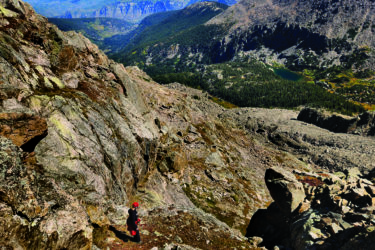The Local newsletter is your free, daily guide to life in Colorado. For locals, by locals.
Coloradans fancy themselves experts when it comes to hiking, but what happens when someone from sea level comes to visit and has ‘hike a fourteener’ on their must-do list? “The trick is to not scare people off about a hike, but to be realistic,” says Jeff Alt, author of A Walk for Sunshine: A 2,160-mile Expedition for Charity on the Appalachian Trail, among many other books.
So, what exactly is the etiquette behind going on a hike with someone less skilled than you? Alt shared with us some of his expert tips.

(Read 5280‘s guide to hiking fourteeners)
Pre-Hike Etiquette
Step 1: Ask about experience, fitness level, and any medical issues. Asking your friends about their fitness level isn’t about making them feel uncomfortable, it’s about safety. And remind your guest—an uphill hike in New York just isn’t the same as an uphill hike in Colorado, especially when you factor in the altitude difference. “If we’re going to take a 10-mile hike, I need to know if my companion has at least ever walked 10 miles,” says Alt. If someone has medical issues or is out of shape, that should affect which trail you decide to take them on. “As the senior hiker, you need to know what you’re up against,” says Alt. If your hiking companion does have medical conditions, be sure to ask ahead of time what you need to know should something happen, and make sure your friend brings along all the necessary medications he or she may need. If the person you’re hiking with has a severe condition—like bad allergies, a propensity for altitude sickness, or diabetes—it’s not a bad idea to have a way to call for back-up (like with a SPOT transmitter) if necessary.
Step 2: Go over gear. If your guest has never hiked before, consider it your duty to fill her in on the essentials. It’s not necessary to spend hundreds of dollars loading up on hiking gear she may never use again, but she’ll at least need the basics. Lend her layers that she may need, or Alt suggests visiting an outfitter to get your friend properly fitted for comfortable trail shoes. Other basics include: synthetic socks, non-cotton clothing, and waterproof, breathable rain gear. “Suggest they dress in layers,” says Alt. “After all, it can be beautiful and 80 degrees in the city and snowing up on a fourteener,” which is why cold-weather gear like a fleece, a hat, and gloves are essentials, as well, especially as we enter the cooler months.
Food and water are, of course, also necessary. “I recommend something with a water hose and bladder system, because you’re more likely to sip water if it’s right there,” says Alt. Those can be expensive, though, so at least be sure your visitor has a water bottle, and that one of you has a way to treat water, especially if you’re planning on a distance hike. “Research the trail you’re hiking ahead of time to see if water is available, and what the conditions are, even if you were there last week,” says Alt. “And always make sure you’ve got a back-up plan for water and a way to keep warm and dry.”
Step 3: Do a shakedown hike. It never hurts to do a practice run before taking to the actual trail, if only to break in those new shoes and any other gear. It’s also a good opportunity to see how a person is doing after a few miles. If they’re not doing so well, perhaps it’s worth suggesting a shorter route, says Alt.
During-Hike Etiquette
Step 1: Always leave an itinerary. Even if it’s just for a day hike, someone should know where you are hiking and when you plan on returning. “I always tell a responsible person where I’m going, what trail I’m taking, and when to call and send someone for us if we don’t show back up,” says Alt. “That way I know my system is in place and someone will look for me on this day or at this time if I’m in a pickle, and I can relax and concentrate on the hike.”
Step 2: Do a pack check. If you helped your new hiker gather her gear, you probably have an idea what she’s planning to bring, but it never hurts to double check before leaving. “If they’re carrying too much, that can be strenuous, and you should divvy up the weight,” says Alt.
Step 3: Start early. Although it’s a good idea to pack a headlamp with extra batteries just in case, starting as early as possible is the best way to avoid being stuck in the dark. “It’s better to have a new hiker finish with energy left, rather than feeling like she needed to make a mad dash back to the car,” says Alt.
Step 4: Let the slowest hiker take the lead. Whether your new hikers are kids or adults, it’s best to let the slowest person set the pace. If you’re in a big group that includes some athletic people, it’s OK to split up and plan on meeting at a designated area. “You always want at least one seasoned hiker with any group,” says Alt. “But by breaking up into fast and slower hikers, you’re allowing the faster people to get their workout in, and those moving slower can go at their own speed and not feel like they’re being pulled along.”
Step 5: Be positive! No matter how athletic or prepared your new hiker is, hiking for the first time can (and probably will) be hard. Remember to offer up lots of words of encouragement. “It can be psychologically defeating if you think you can never catch up on a hike,” says Alt. “And that’s not what we’re trying to do.”








